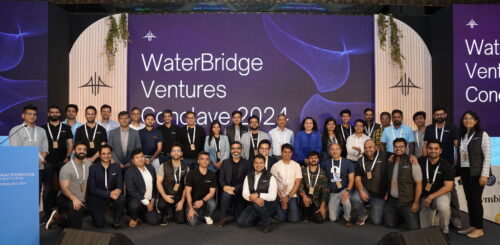
01About Us
We are committed to being the first and the most active VC partners to our founders
As a home-grown VC, we have the DNA required to be an early partner with India-centric teams. With tech-disruption at the core, we back founders building for India or, from India. We aim to be the first institutional cheque for founders and the most active partner, committed to leveraging our network and expertise in order to catalyze our founders' superpowers.
We're thesis driven and disciplined about portfolio construction. Our efforts are focused on stated sectors where we can connect the dots, offer deep expertise and optimize human capital. The team approaches every discussion with humility - to keep learning, while being honest in our feedback and engagement. We're honoured to frequently connect with passionate entrepreneurs building game changing businesses.
We back founders who are solving big problems through tech disruption

We believe passion is innate and not acquired. We prefer EQ over IQ. We back founders with a high opportunity cost of entrepreneurship
We believe in founders who are going after large markets with a strong tech-driven, product-market alignment
We have a local approach with a global outlook. We have the ability to spot large local market problems spanning India’s breadth often with contrarian themes
We put founders ahead of markets, partnering on their 0 to 1 journeys. Our value-add construct and deep involvement sets us both for success
We are thesis driven. We invest in 5 - 6 high conviction bets every year. We continue to follow-on and support founders until Series C
Our Values
We back entrepreneurs that are solving big problems through tech disruption
Aligning with Founders
Partnering with the right founders and supporting their journeys

The Ganga, at Rishikesh, is where the river is still in its early phase. While Rishikesh is a beacon of tranquility, the mighty Ganges here is known for white water river rafting and rapids upto grade IV

Clarity of Purpose
Knowing who we are and where we are headed

The Umngot river, flowing through Shandong, Meghalaya, North East India. The water is so pristine and clear, one can peer into the bottom and count stones.
Image: Vikram Ramachandran

Delivering Resilient Outcomes
Generating outsized economic and social returns, multiple times

The Royal Bengal Tiger, Sundarban, West Bengal, India. The iconic big cat has survived multiple extinction threats to prevail and persist on Earth for the last 2 million years

Patiently building value
Being patient and persistent while generating lasting outcomes

The mangrove forest, Sundarbans, West Bengal, India. The Sundarbans, one of the largest mangrove forests in the word, lies on the delta of Ganga and Brahmaputra rivers, as these mighty rivers traverse thousands of kilometers, meandering through the plains, to finally reach the Bay of Bengal

Ethical decision making
Knowing the factors that should drive decisions

Gandhi ji's Talisman. One of the last notes left behind by Gandhi ji in 1948, expressing his deepest social thought "I will give you a talisman. Whenever you are in doubt, or when the self becomes too much with you, apply the following test. Recall the face of the poorest and the weakest man [woman] whom you may have seen, and ask yourself, if the step you contemplate is going to be of any use to him [her]. Will he [shel gain anything by it? Will it restore him [her] to a control over his [her] own life and destiny? In other words, will it lead to swaraj [freedom] for the hungry and spiritually starving million? Then you will find your doubts and your self melt away". Mahatma Gandhi: The Last Phase, Vol. II (1958), p.65

Embracing Sustainability
Internalizing and actioning principles of sustainability

The Ganga river, flowing through Haridwar, Uttarakhand, North India. The Ganga is amongst the largest rivers in India, flourishing the gigantic northern plains, sustaining life for centuries. Haridwar is where the river leaves the hills and enters plains, symbolizing a new phase in its long and varied journey.

Our Investment Themes

 B2B Manufacturing and Commerce
B2B Manufacturing and Commerce
Regulatory and geopolitical developments have positioned India to be the next manufacturing powerhouse in Asia.
Indian manufacturing is still primarily MSME-led, characterised by a frugal cost base, but plagued with extremely fragmented revenue and margins. B2B commerce models that demonstrate early PMF, signs of capital-efficient growth, promise of the founder’s ability to get access to subsequent growth capital and eventual profitability at scale, are more likely to attract capital.
Themes of interest are around the 5Ms – Materials (IP-led manufacturing of value-add input products), Machines (aggregation of underutilised capacity), Manpower (design-led product innovation), Money (opportunistic plays in PLI-driven manufacturing) and Market (efficient supply chain and distribution plays)
Portfolio
B2B Manufacturing and Commerce
 Building Global Businesses From India
Building Global Businesses From India
Indian businesses are at an inflection point. They have access to the talent and resources needed to build world-class, innovative companies across AI-led SaaS, DeepTech, global platforms and brands—all at a fraction of what it would cost abroad.
As SaaS evolves into AI-driven models, India is well positioned to lead in horizontal, vertical, and infrastructure-focused AI disruption. Pure product excellence is no longer enough to scale, distribution and building a repeatable sales playbook to land large accounts are critical for success.
DeepTech is undergoing regulatory tailwinds and massive R&D activity. Capital availability is still challenging, but that landscape is changing rapidly as more companies stride towards revenue generation. India’s cost advantage, growing talent pool, & faster turnaround times make it ripe for global success. Key areas of interest include space tech, industrial robotics, advanced materials and synthetic biology.
We believe India is now positioned strongly to build global platforms & brands for the world. This is driven by strong geopolitical tailwinds (diversification away from China), UPI-driven FinTech scalability offering global learnings, government-led manufacturing initiatives, and rising India’s soft power on the world stage.
Building Global Businesses From India
 Consumption and Micro-entrepreneurship
Consumption and Micro-entrepreneurship
India’s consumer market is bifurcating into two distinct opportunities totalling $1.1T by 2030 – an urban–focused $620B market across 25 major cities as Prime TAM 1, and a broader $456B market spanning 443 emerging towns as Value TAM 2. These two TAMs are united by their behavioral traits (status seeking, bargain hunting, cashback and “jugaad” culture), but differ in how and where they would spend their time and money.
Prime TAM 1 consumers are characterized by widespread digital adoption, global influence and overall higher discretionary spending across multiple sectors. Our proprietary, forward-looking 4S framework (Spending, Secondary Income, Socialising & Savouring) captures their spending patterns as they evolve over the next 10 years.
Value TAM 2 is a high-volume, value-conscious market, prioritising affordability of and access to essential offerings. As their purchasing power grows, we have mapped their discretionary spends into our proprietary 5 Needs framework (Time, Access, Efficiency, Save/Earn and Aspiration).
Businesses building India-centric models, leveraging digital platforms to offer localised access, competitive pricing and quality service to new internet audiences across convenience, community and the gig economy, are of interest.
Portfolio
BimaKavach, Chalo, Citymall, EloElo, Magicpin, YellowMetal, ZET
Consumption and Micro-entrepreneurship
 B2B Manufacturing and Commerce
B2B Manufacturing and Commerce
Regulatory and geopolitical developments have positioned India to be the next manufacturing powerhouse in Asia.
Indian manufacturing is still primarily MSME-led, characterised by a frugal cost base, but plagued with extremely fragmented revenue and margins. B2B commerce models that demonstrate early PMF, signs of capital-efficient growth, promise of the founder’s ability to get access to subsequent growth capital and eventual profitability at scale, are more likely to attract capital.
Themes of interest are around the 5Ms – Materials (IP-led manufacturing of value-add input products), Machines (aggregation of underutilised capacity), Manpower (design-led product innovation), Money (opportunistic plays in PLI-driven manufacturing) and Market (efficient supply chain and distribution plays)
Portfolio
 Building Global Businesses From India
Building Global Businesses From India
Indian businesses are at an inflection point. They have access to the talent and resources needed to build world-class, innovative companies across AI-led SaaS, DeepTech, global platforms and brands—all at a fraction of what it would cost abroad.
As SaaS evolves into AI-driven models, India is well positioned to lead in horizontal, vertical, and infrastructure-focused AI disruption. Pure product excellence is no longer enough to scale, distribution and building a repeatable sales playbook to land large accounts are critical for success.
DeepTech is undergoing regulatory tailwinds and massive R&D activity. Capital availability is still challenging, but that landscape is changing rapidly as more companies stride towards revenue generation. India’s cost advantage, growing talent pool, & faster turnaround times make it ripe for global success. Key areas of interest include space tech, industrial robotics, advanced materials and synthetic biology.
We believe India is now positioned strongly to build global platforms & brands for the world. This is driven by strong geopolitical tailwinds (diversification away from China), UPI-driven FinTech scalability offering global learnings, government-led manufacturing initiatives, and rising India’s soft power on the world stage.
 Consumption and Micro-entrepreneurship
Consumption and Micro-entrepreneurship
India’s consumer market is bifurcating into two distinct opportunities totalling $1.1T by 2030 – an urban–focused $620B market across 25 major cities as Prime TAM 1, and a broader $456B market spanning 443 emerging towns as Value TAM 2. These two TAMs are united by their behavioral traits (status seeking, bargain hunting, cashback and “jugaad” culture), but differ in how and where they would spend their time and money.
Prime TAM 1 consumers are characterized by widespread digital adoption, global influence and overall higher discretionary spending across multiple sectors. Our proprietary, forward-looking 4S framework (Spending, Secondary Income, Socialising & Savouring) captures their spending patterns as they evolve over the next 10 years.
Value TAM 2 is a high-volume, value-conscious market, prioritising affordability of and access to essential offerings. As their purchasing power grows, we have mapped their discretionary spends into our proprietary 5 Needs framework (Time, Access, Efficiency, Save/Earn and Aspiration).
Businesses building India-centric models, leveraging digital platforms to offer localised access, competitive pricing and quality service to new internet audiences across convenience, community and the gig economy, are of interest.
Portfolio
BimaKavach, Chalo, Citymall, EloElo, Magicpin, YellowMetal, ZET


